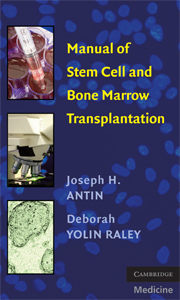Book contents
- Frontmatter
- Contents
- Acknowledgments
- Manual of Stem Cell and Bone Marrow Transplantation
- 1 Rationale for Transplantation
- 2 Types of Transplantation
- 3 HLA Matching in Allogeneic Transplantation
- 4 Stem Cell Source
- 5 Pretransplant Evaluation and Counseling of Patient and Donor
- 6 Conditioning Regimens
- 7 Stem Cell Infusion
- 8 ABO Compatibility
- 9 Engraftment
- 10 Preventative Care
- 11 Transplant-Related Complications
- 12 Graft-Versus-Host Disease – Prophylaxis and Acute
- 13 Graft-Versus-Host Disease – Chronic
- 14 Engraftment Syndrome
- 15 Infectious Disease
- 16 Graft Rejection And Failure
- 17 Gastrointestinal Complications
- 18 Pulmonary Complications
- 19 Veno-Occlusive Disease
- 20 Special Transfusion-Related Situations
- 21 Cardiovascular Complications
- 22 Neurologic Complications
- 23 Cystitis
- 24 Donor Lymphocyte Infusion
- 25 Transplantation: Regulation And Accreditation
- Appendix
- Index
10 - Preventative Care
Published online by Cambridge University Press: 23 November 2009
- Frontmatter
- Contents
- Acknowledgments
- Manual of Stem Cell and Bone Marrow Transplantation
- 1 Rationale for Transplantation
- 2 Types of Transplantation
- 3 HLA Matching in Allogeneic Transplantation
- 4 Stem Cell Source
- 5 Pretransplant Evaluation and Counseling of Patient and Donor
- 6 Conditioning Regimens
- 7 Stem Cell Infusion
- 8 ABO Compatibility
- 9 Engraftment
- 10 Preventative Care
- 11 Transplant-Related Complications
- 12 Graft-Versus-Host Disease – Prophylaxis and Acute
- 13 Graft-Versus-Host Disease – Chronic
- 14 Engraftment Syndrome
- 15 Infectious Disease
- 16 Graft Rejection And Failure
- 17 Gastrointestinal Complications
- 18 Pulmonary Complications
- 19 Veno-Occlusive Disease
- 20 Special Transfusion-Related Situations
- 21 Cardiovascular Complications
- 22 Neurologic Complications
- 23 Cystitis
- 24 Donor Lymphocyte Infusion
- 25 Transplantation: Regulation And Accreditation
- Appendix
- Index
Summary
Preventative care will vary on the basis of transplant type, protocol, medications, and pretransplant viral studies.
INFECTION PROPHYLAXIS
Please see Chapter 15 on infectious diseases.
HOSPITAL INFECTION CONTROL
Hospital personnel should follow standard infection control and Center for Disease Control (CDC) guidelines to prevent nosocomial infections. The efficacy of different transplant-specific precautions in preventing nosocomial infections has not been studied. Hand washing continues to be the single most critical and effective procedure for preventing infection. If gloves are utilized, they should be changed between patients. All equipment should be sterilized or disinfected and Environment Protection Agency (EPA) registered.
Allogeneic hematopoietic stem cell transplantation (HSCT) patients should be placed in private rooms that have >12 air exchanges per hour and high-efficiency particulate air filters (HEPA) that are capable of removing particles ≥0.3 μm in diameter. It is generally considered good practice to treat all immuno-compromised people in HEPA-filtered rooms although the data are less clear than for allogeneic HSCT.
GUT DECONTAMINATION
Gut decontamination is used in some centers in all myeloablative and cord allogeneic procedures. Its use is most important when the risk of GVHD is higher (i. e., mismatched and URDs). In autologous and T-cell depleted patients an alternative is to use levofloxacin 500 mg PO starting on day 1 and continue through engraftment.
- Type
- Chapter
- Information
- Manual of Stem Cell and Bone Marrow Transplantation , pp. 43 - 51Publisher: Cambridge University PressPrint publication year: 2009



